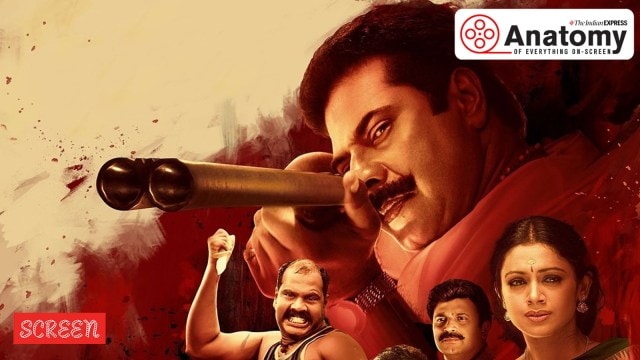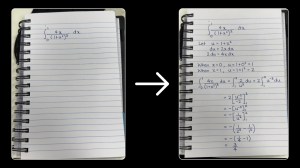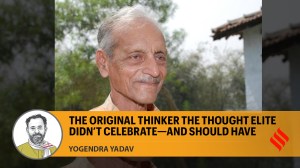Malayalam cinema, like many of its counterparts, was trapped in a cycle of creative stagnation in the 2000s when the industry predominantly produced formulaic stories centred around hypermasculine heroes. Often led by superstars like Mammootty and Mohanlal, these films were major box-office successes too. While such films still enjoy immense popularity, particularly among devoted fans of the stars, they have, however, increasingly come under scrutiny for promoting elitism, misogyny and toxic masculinity.
Although many initially dismissed these criticisms as unwarranted, a considerable number have since begun to recognise the problematic tones of these films. Yet, it would be inaccurate to say such movies have lost their fan base, as evidenced by the high anticipation and business surrounding the recent re-release of director Shaji Kailas’ Mammootty-starrer action drama Valyettan (2000), after being remastered in 4K Dolby Atmos. This is despite the action drama being the paragon of everything problematic in the aforementioned type films containing high levels of elitism, misogyny and toxic masculinity, which also includes titles like Narasimham (2000), Ravanaprabhu (2001), Dubai (2001), Thandavam (2002), Onnaman (2002), Chathurangam (2002), Mr Brahmachari (2003) and Chronic Bachelor (2003), among others.

ICYMI | Suriya-Siva’s Kanguva made me realise I was too hard on Vijay, Jr NTR for GOAT and Devara, and owe them an apology
Initially, the trend of re-releases in Kerala seemed charming, particularly with classics like Manichitrathazhu (1993) and Spadikam (1995) — seminal works in Malayalam cinema’s legacy — and Devadoothan (2000), which gained a cult following after a poor initial release 24 years ago, returning to theatres with enhanced audio and visuals. These re-releases felt like heartfelt tributes to cinema itself. However, over time, this trend too appears to have been overtaken by greed, with producers indiscriminately re-releasing films without any substantial reason.
For instance, though movies like Paleri Manikyam: Oru Pathirakolapathakathinte Katha (2009) and Anwar (2010) were also brought back to cinemas, none replicated the success of Manichitrathazhu, Spadikam or Devadoothan. This raises the question: why re-release films that already had their moment of glory and continue to perform well on TV, OTT platforms or YouTube?
At a time when Malayalam cinema is making significant progress by producing exceptional and less problematic films, showing signs of unlearning and relearning, and distancing itself from the ghosts of its past, the celebration of past blunders is indeed unnecessary and reviving such films is undeniably a retrograde step.
Watch Mammootty’s Valyettan trailer here:
After creating the Mohanlal-starrer Narasimham, which drew inspiration from director KS Ravikumar’s Rajinikanth blockbuster Padayappa (1999), Shaji Kailas decided to craft a film with a similar tone and aesthetic for Mammootty. A quintessential superstar vehicle that elevated its hero to unparalleled heights with each scene surpassing the last in sheer spectacle, Padayappa left a profound mark on commercial filmmakers, especially Shaji. This influence gave birth to Narasimham, an unabashed mass masala film in Malayalam where the hero dominated every frame.
Story continues below this ad
Interestingly, Narasimham also featured Mammootty in a cameo, a role that has since become one of the most celebrated guest appearances in Malayalam cinema. While Narasimham showcased Mohanlal as a self-reliant powerhouse, who also has a funny side to him, Valyettan saw Shaji and screenwriter Ranjith take a different route. They crafted Mammootty’s character to reflect his real-life persona: the all-encompassing patriarch, the leader of the masses and a figurehead of strength and unity — the Elder Brother. For the story, the makers turned to the inexhaustible treasure trove of the Mahabharata, using the tale of the Pandavas as the foundation for their narrative.
 Mammootty plays Arakkal Madhavanunni in Shaji Kailas’ Valyettan. (Image: George S/Instagram)
Mammootty plays Arakkal Madhavanunni in Shaji Kailas’ Valyettan. (Image: George S/Instagram)
Not only does Valyettan draw from the Hindu epic Mahabharata for its core story, but the whole film is filled with savarna elements and problematic themes as if the makers were determined to make a blockbuster by catering to the harmful mindset of the time. For absolutely no reason at all, the film’s title sequence features the song “Smaraami Vaishnavachaarumoorthe,” which sounds like a Hindu devotional hymn, accompanied by serene visuals of the River Bharata flowing peacefully, which all stand in stark contrast to Valyettan’s tone as an unabashed mass masala actioner. From this very point, Shaji appears to capitalise on Brahminical motifs.
In a not-so-innocent “creative” decision, the protagonist Madhavanunni (played by Mammootty) is given the family name Arakkal, the same as the only Muslim royal family in the Malabar region. Despite having numerous options, Ranjith strategically repurposed the name for an aristocratic Nair family in the film, with its members, particularly Madhavanunni’s maternal uncle Kuttikrishnan Nair (Kozhikode Narayanan Nair) and his son Patteri Sivaraman Nair (Sai Kumar) — the main antagonist — displaying overt caste pride throughout the movie.
While the origins of the Arakkal dynasty of Kannur are steeped in legend, most accounts reference a conversion to Islam. Mubashir VP, a PhD scholar in Islamic Studies, noted in an article for New Age Islam that the Arakkal family was a branch of the Kolathiri kingdom and converted to Islam. Thence, it doesn’t seem far-fetched to interpret Ranjith’s appropriation of the name Arakkal as a very early version of the Hindutva’s Ghar Wapsi programme.
Madhavanunni, the eldest of five brothers, mirrors Yudhishthira from the Mahabharata, serving as the moral authority and decision-maker for his siblings — Raghu (Siddique), Dasan (Manoj K Jayan), Shankaran Kutty alias Monkuttan (Sudheesh) and Appu (Vijayakumar) — who collectively embody the Pandavas. Standing against them is their cousin Sivaraman, a Duryodhana-like figure determined to bring about Madhavanunni’s downfall. Supporting Sivaraman is his father, the ageing and visually impaired Kuttikrishnan Nair, a clear parallel to Dhritarashtra. To further emphasise the elite status of the fictional Arakkal family, the makers chose Cheloor Mana — a renowned ancestral home of the Namboodiris, located in Thriprayar, Thrissur district — as their ancestral home in the film.
Movie Reviews: Her | Sookshmadarshini | Hello Mummy
Story continues below this ad
The film’s “connection” to Kannur and its anti-Islamic undertones extend beyond the apparent appropriation of Arakkal. While the central story is a Yudhishthira vs Duryodhana tale, Ranjith introduced a secondary villain to Valyettan: Mambaram Bava Haji (NF Varghese), a Muslim man portrayed as a ruthless mafia don who runs a parallel government from his residence. While Kannur was the Arakkal dynasty’s main centre, Mambaram is also a place in the Kannur district and is located in Thalassery taluk. Given that the film is set in Thrissur, a district with no shortage of significant locales for names, it is hard to believe Ranjith chose these elements arbitrarily, particularly since he’s a self-proclaimed Leftist.
The movie’s problematic nature doesn’t end there, with its treatment of women being especially egregious. What makes these troubling depictions even more baffling is that they exist solely to glorify Madhavanunni. For a significant portion of the film, Devi (Shobana) is portrayed as a new joinee at the local Anganwadi and has moved into one of Madhavanunni’s rental properties after relocating to the area. However, it is revealed only later that she is actually his wife — a marriage he entered into almost as an act of “service” after her wedding was abruptly called off at the last minute. Madhavanunni, however, kept their relationship a secret from his brothers and others, believing it would set a “bad precedent” to marry someone he chose without involving his family. To maintain this facade, he goes to absurd lengths, speaking about Devi only in a disrespectful and dismissive manner. In one instance, before their marriage is revealed to all, Devi visits the Arakkal house to see Madhavanunni because he seldom visits her. His reaction to her presence is one of disgust, projecting a toxic, hyper-masculine persona.
 Malayalam megastar Mammootty with co-stars Siddique, Manoj K Jayan, Sudheesh and Augustine. (Image: George S/Instagram)
Malayalam megastar Mammootty with co-stars Siddique, Manoj K Jayan, Sudheesh and Augustine. (Image: George S/Instagram)
The film also perpetuates harmful stereotypes about disability, particularly in its depiction of Monkuttan, who has a leg impairment. Throughout the movie, he is either mocked or subjected to exaggerated pity by all his brothers. For example, within 30 seconds of screen time, Madhavanunni delivers two lines that reveal deeply prejudiced attitudes towards people with disabilities. First, he jokingly remarks that Monkuttan’s body lacks “finishing” physically, and immediately afterwards, he expresses concern to Raghu that no woman — except perhaps a financially struggling neighbour — would consider marrying “someone like him with such shortcomings.” Notice the classist undertone in that remark too. While some might argue that these portrayals reflect the filthy societal attitudes of the (apparently bygone) eras, it’s pathetic that some makers can derive humour only cynically from others’ sufferings, as though they have no better tools at their disposal than sadism.
Despite being one of the weakest scripts in terms of emotional depth in Ranjith’s repertoire, Valyettan remains a fan favourite and this enduring appeal largely stems from Mammootty’s commanding presence and Shaji’s ability to capitalise on the traits that define the megastar as the ideal embodiment of Malayali masculinity. From his authoritative posture, striking body language and magnetic screen presence to his masterful dialogue delivery, precise enunciation and chemistry with co-stars, Mammootty has excelled here. His ability to convey vulnerabilities and emotions through subtle expressions and gestures, rather than overt displays, further elevates his performance as Madhavanunni.
Story continues below this ad
While Valyettan doesn’t boast as many memorable mass one-liners as Ranjith’s Devasuram (1993), Aaraam Thampuran (1997), Narasimham or Ravanaprabhu, Mammootty’s powerful performance compensates for this shortcoming. George’s makeup and Ezhumalai’s costumes for the megastar also contributed to the character’s iconic stature. Rajamani’s exceptional background score, which has since become legendary, has also played a key role in Valyettan’s continuing popularity. Among the songs composed by Mohan Sitara with lyrics by Girish Puthencherry, the track “Niranaazhi Ponnil” stands out as a defining piece, symbolising both Malayali masculinity and Mammootty’s on- and off-screen persona as a patriarch.
Though the supporting characters, including Devi, are relegated to little more than background roles, the actors manage to leave an impression. Notable performances include Kalabhavan Mani as Kattipalli Pappan, Poornima Indrajith as Pappan’s sister Lakshmi and Sai Kumar as Patteri Sivaraman Nair. Additionally, the stunts choreographed by Rocky Rajesh and King Pazhaniraj also significantly enhance the film’s mass appeal.
All these factors have collectively cemented Valyettan as a cherished film for many. The movie was later remade in Kannada as Jyeshta, helmed by Baashha director Suresh Krissna, with Vishnuvardhan in the lead role. However, it’s worth remembering that 24 years have passed since its release and some things are best left as relics of their time rather than revisited and celebrated repeatedly.
This is especially relevant today when both Malayalam cinema and Mammootty are being celebrated for bold, unconventional films such as Rorschach (2022), Nanpakal Nerathu Mayakkam (2023), Kaathal – The Core (2023) and Bramayugam (2024), which push artistic boundaries and challenge the megastar as an actor. While it can be argued that movies like Valyettan are products of their time and only mirror societal biases, the revival and re-celebration of such movies are both worrisome and pitiful.
Cinema cannot exist in a vacuum; it’s all about the discussions that follow. In the Cinema Anatomy column, we delve into the diverse layers and dimensions of films, aiming to uncover deeper meanings and foster continuous discourses.




 Mammootty plays Arakkal Madhavanunni in Shaji Kailas’ Valyettan. (Image: George S/Instagram)
Mammootty plays Arakkal Madhavanunni in Shaji Kailas’ Valyettan. (Image: George S/Instagram) Malayalam megastar Mammootty with co-stars Siddique, Manoj K Jayan, Sudheesh and Augustine. (Image: George S/Instagram)
Malayalam megastar Mammootty with co-stars Siddique, Manoj K Jayan, Sudheesh and Augustine. (Image: George S/Instagram)































